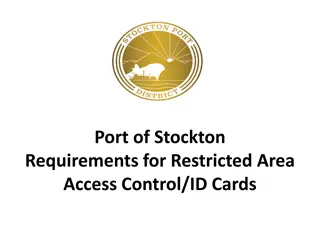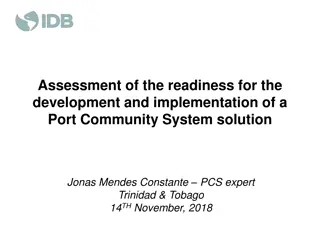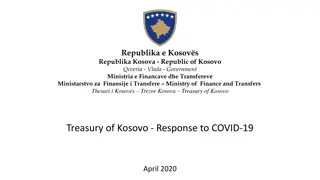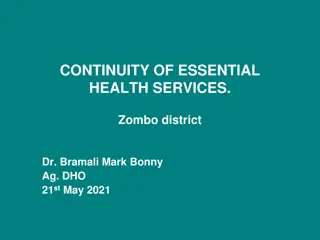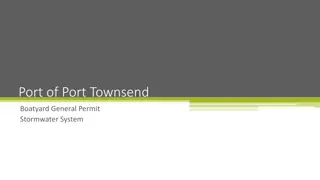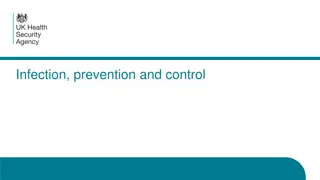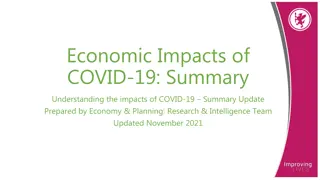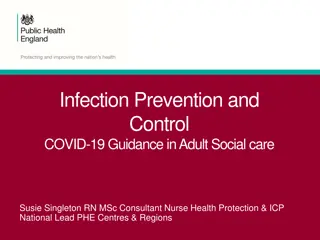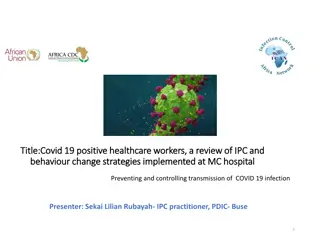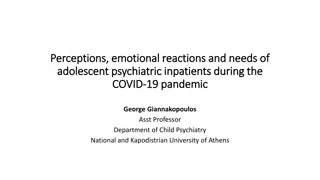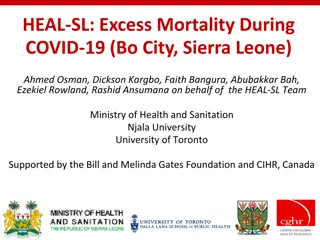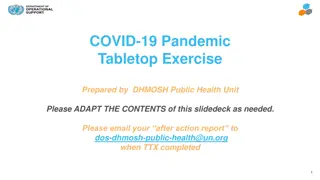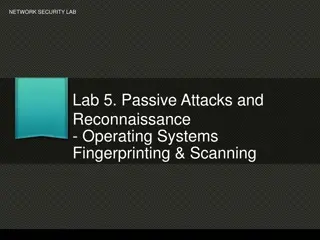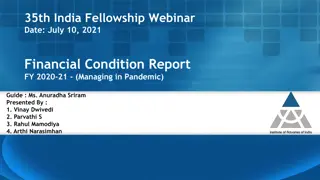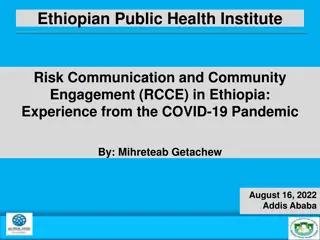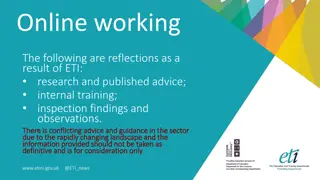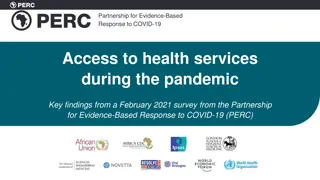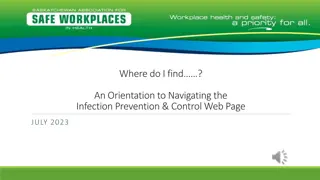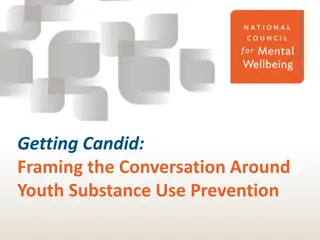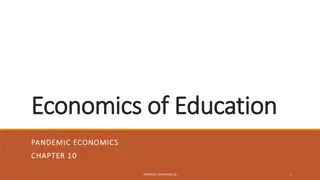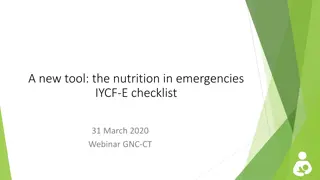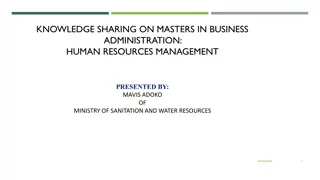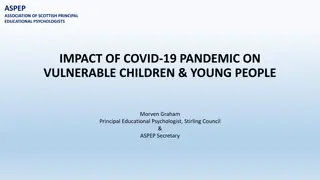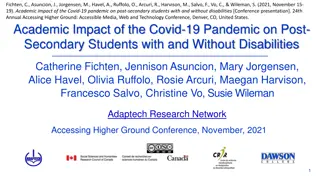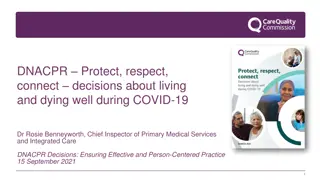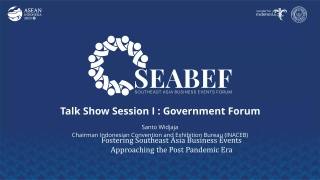Effective Infection Control in Port Operations During the COVID-19 Pandemic
Diseases like COVID-19 spread person-to-person through respiratory droplets. Implementing infection prevention measures in ports is crucial to safeguard against outbreaks. Key principles include hand hygiene, use of PPE, and proper sanitation. Countries and organizations recommend screening protocols, social distancing, and regular disinfection for transport workers to minimize transmission risks. Prioritizing these measures can help protect port workers and the community from infectious diseases.
Download Presentation

Please find below an Image/Link to download the presentation.
The content on the website is provided AS IS for your information and personal use only. It may not be sold, licensed, or shared on other websites without obtaining consent from the author. Download presentation by click this link. If you encounter any issues during the download, it is possible that the publisher has removed the file from their server.
E N D
Presentation Transcript
Infection prevention and control of COVID in ports
Overview How are diseases transmitted from person to person? What are the principles of infection prevention and control What IPC measures are other countries / organisations recommending for the transport industry/workers? How can we apply this knowledge to protect us while we protect our country? Administrative controls = screening and awareness, people flow, health promotion Environmental controls = ventilation, airflow, Personal protective equipment = use of masks, gloves, hand hygiene
How are diseases transmitted from person- to-person?
How are diseases transmitted from person-to-person? Before causing disease, a bacterium or virus must ATTACH to a cell Viruses attach to specific proteins on the surface of human cells After attachment, they are able to enter the cell and cause disease. The site of the specific receptor tells us how the organism is transmitted.
How is coronavirus transmitted from person-to-person? Already (!!) researchers have understood that SARS-CoV-2 is very much SARS-CoV-1 (cause of SARS outbreak in 2003). It most likely binds to the same cell surface receptor angiotensin converting enzyme (ACE) which is found on cells surfaces in the respiratory tract
How are diseases transmitted from person-to-person? Coronaviruses of the beta-coronavirus clade must attach to proteins on the surface of epithelial cells in the upper and lower airways called angiotensin converting enzyme (ACE) Therefore carrier droplets need not be very small. Tuberculosis bacteria must attach to proteins on the surface of the alveolar macrophage Therefore the carrier droplets must be small enough to enter the alveoli
How are diseases transmitted from person-to-person? Coughing generates droplets of different sizes Fennelly et al counted the number of particles of each size (histogram above) generated when a patient coughs They range from 7mm-0.65um Larger droplets fall to the ground within a 1-2m radius of the person Droplet nuclei that are small enough to enter the alveoli remain suspended in air for up to 12 hours.
How are diseases transmitted from person-to-person? The Wells-Riley equation Risk of infection following exposure depends on Particles Volume Exposure time x Particles: Volume: Exposure time: Production of infectious droplet nuclei Volume of air and ventilation Duration of exposure to contaminated air 8
How are diseases transmitted from person-to-person? Coronavirus Airborne transmission Inhaling droplets nurclei (10-20um in diameter) Persons breathing the same air E.g. influenza, measles, chickenpox, Control Gloves, N95 masks, +/- gowns, masks, visors (to prevent mucous membrane splashes, contamination of clothing) Direct contact Touching an ill persons or a contaminated surface E.g. agents of diarrhoea, skin infections, common cold, ebola virus Control Gloves, +/- gowns, masks, visors (to prevent mucous membrane splashes, contamination of clothing) Vector transmission Contact with vector E.g. malaria, dengue, Zika, Control Prevent/eliminate exposure to vector Chemoprophylaxis if possible Droplet transmission Inhaling droplets (up to 1/4mm in diameter) Persons within 2m radius are at risk. On aircraft, 2 rows behind and in front E.g. agents of bacterial pneumonia, Neisseria meningitidis Control Gloves, surgical masks, +/- gowns, masks, visors (to prevent mucous membrane splashes, contamination of clothing)
How are diseases transmitted from person-to-person? Coronavirus Airborne transmission Inhaling droplets nurclei (10-20um in diameter) Persons breathing the same air E.g. influenza, measles, chickenpox, Control Gloves, N95 masks, +/- gowns, masks, visors (to prevent mucous membrane splashes, contamination of clothing) Direct contact Touching an ill persons or a contaminated surface E.g. agents of diarrhoea, skin infections, common cold, ebola virus Control Gloves, +/- gowns, masks, visors (to prevent mucous membrane splashes, contamination of clothing) Vector transmission Contact with vector E.g. malaria, dengue, Zika, Control Prevent/eliminate exposure to vector Chemoprophylaxis if possible Droplet transmission Inhaling droplets (up to 1/4mm in diameter) Persons within 2m radius are at risk. On aircraft, 2 rows behind and in front E.g. agents of bacterial pneumonia, Neisseria meningitidis Control Gloves, surgical masks, +/- gowns, masks, visors (to prevent mucous membrane splashes, contamination of clothing)
How are diseases transmitted from person-to-person? Survival in the environment depends on pH Innoculum size Dryness Temperature Exposure to disinfectants
How are diseases transmitted from person-to-person? Coronavirus Airborne transmission Inhaling droplets nurclei (10-20um in diameter) Persons breathing the same air E.g. influenza, measles, chickenpox, Control Gloves, N95 masks, +/- gowns, masks, visors (to prevent mucous membrane splashes, contamination of clothing) Direct contact Touching an ill persons or a contaminated surface E.g. agents of diarrhoea, skin infections, common cold, ebola virus Control Gloves, +/- gowns, masks, visors (to prevent mucous membrane splashes, contamination of clothing) Vector transmission Contact with vector E.g. malaria, dengue, Zika, Control Prevent/eliminate exposure to vector Chemoprophylaxis if possible Droplet transmission Inhaling droplets (up to 1/4mm in diameter) Persons within 2m radius are at risk. On aircraft, 2 rows behind and in front E.g. agents of bacterial pneumonia, Neisseria meningitidis Control Gloves, surgical masks, +/- gowns, masks, visors (to prevent mucous membrane splashes, contamination of clothing)
Principles of infection prevention and control
Principles of infection control The Wells-Riley equation Eradicate the particles by Teach cough hygiene Giving people who cough a surgical mask Risk of infection following exposure depends on Reduce each person s exposure by Early screening of cases Triaging and seeing patients who cough first Particles Volume Exposure time x Particles: Volume: Exposure time: Production of infectious droplet nuclei Volume of air and ventilation Duration of exposure to contaminated air Decrease the concentration of particles in the air by Standing >1m from a person Increasing the ventilation rate Opening windows 14
Principles of infection control Must therefore be achieved through elimination and control of these infectious TB particles Prevent people from inhaling the particles and reduce their risk of developing TB disease Decrease the number of particles formed by people with TB disease Remove the particles from the air ie clean the air
Principles of infection control Create an enabling environment Reduce risk of inhaling infectious TB particles and developing TB disease Reduce formation of infectious particles Remove infectious particles Administrative Controls Environmental Controls PPE and risk Reduction
Ability to prevent transmission of infectious organisms The relative ability of each component of IPC is shown by the size of the circle Screening and triage (administrative controls) are most important Environmental controls are important PPE is the least effective
Principles of infection control What is a N95 respirator? It is a filter which traps infectious particles and stops them from being inhaled. Masks which do this are called particulate filter respirators Droplet nuclei that are responsible for airborne transmission are 1-5 m in diameter. Masks that are able to prevent TB infection must capture particles this size and larger.
Principles of infection control A surgical mask: Has only 50% filter efficiency it only stops 50% of particles. It lacks a tight facial seal. It is useful to capture infectious particles coming from the person who is wearing the mask Surgical masks stop surgeons spitting into the operating field!!
Principles of infection control N95 respirators will NOT work if: They are not properly fitted If the wearer has facial hair (beard) preventing a proper fit They are damaged or crushed They are saturated (reused until the filter capacity has been exceeded) They get wet (even if they dry again).
Principles of infection control Fit the mask according to manufacturer s instructions. Do not touch outside of mask on placing, and on removal Once the mask is in place, inhale sharply. The mask should be drawn in towards your face, indicating that a negative pressure has been generated. If the mask does not draw in towards your face, or you feel leakage at the edges, adjust straps by pulling back along the sides and/or reposition respirator. Repeat until mask is sealed properly.
Principles of infection control Who should use N95 masks, and where? Who should use N95 masks, and where? Where? Where airborne transmission is the dominant mode of transmission Where administrative and environmental controls cannot significantly reduce the risk to HCW Examples: Where newly diagnosed TB or TB suspects are seen MDR/XDR TB facilities Respiratory isolation facilities WHO? Health Care workers (NOT patients!) Any cadre For protection of HCW from TB infection or airborne transmission or where there is intense risk of transmission (e.g. intubating or suctioning a patient in ICU)
Principles of infection control Cleaning and disinfection of the environment Hands alcohol handsanitizer Environment General soap and water If contamination suspected, can use ethanol, bleach, quaternary ammonium compounds See ECDC reference document
How can we prevent transmission of SARS-CoV-2 in our work environment?
How can we prevent transmission of SARS-CoV-2? Ensure ventilation is good, and aircon is working Provide bins for disposal of tissues, masks Stand away from people (social distancing) Clean the environment Administrative controls Environmental controls Personal protective equipment/practice Hand hygiene Don t touch face/mouth Keep distance. If can t keep distance, use surgical mask and gloves Screen everyone early Use health promotion messaging re symptoms Teach cough hygiene
How can we prevent transmission of SARS-CoV-2?
How can we prevent transmission of SARS-CoV-2? Administrative controls Facilitate hygiene soap, red bins etc Screen and triage early. Give people who cough a mask When screening Don t touch person stand far from them Don t touch mouth/eyes etc Wash hands / use hand sanitiser If using gloves/mask, use properly!!! On identification of a symptomatic person Give them a mask Isolate them Use droplet precautions
How are other countries protecting port health officials?
How are other countries protecting port health officials? https://www.gov.uk/government/publications/covid-19-guidance-for-staff-in-the-transport-sector/covid-19-guidance-for- staff-in-the-transport-sector
How are other countries protecting port health officials? https://www.gov.uk/government/publications/covid-19-guidance-for-staff-in-the-transport-sector/covid-19-guidance-for- staff-in-the-transport-sector
How are other countries protecting port health officials? https://www.gov.uk/government/publications/covid-19-guidance-for-staff-in-the-transport-sector/covid-19-guidance-for- staff-in-the-transport-sector
Questions? Public Hotline 0800-029-999


